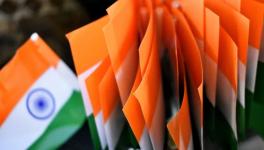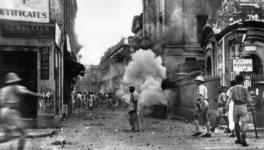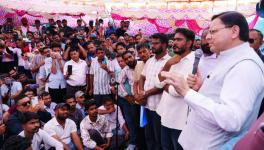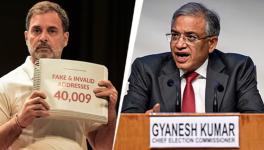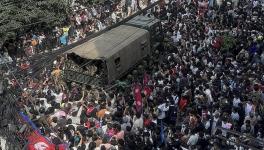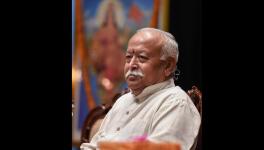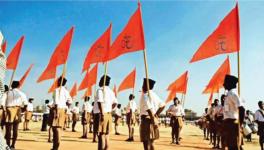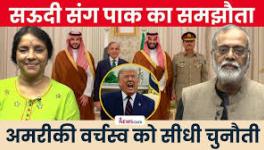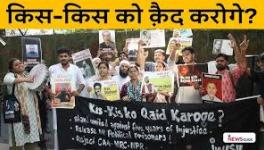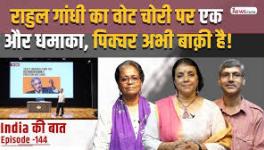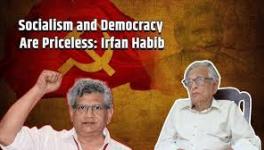#Harshtags for Riots: Shamli in Twitter
Recently a twitter user launched a venomous attack on the Muslim community with the hashtag #GodhraAgain. Linking the recent 'rail roko' protest in Shamli, UP to the 2002 burning of Sabarmati Express at Godhra Station, the tweets incited murderous violence against Muslims. To discuss this issue, Newsclick interviewed filmmaker Nakul Singh Sawhney whose recent documentary, "Muzaffarnagar Baki Hai” provides an in-depth insight into the events leading up to the 2014 Muzaffarnagar riots. Nakul characterises this social media campaign as more than an a mere attack on the minority community. Putting it in a historical context, he traces this incitement to a larger agenda of communal polarisation in Uttar Pradesh for upcoming elections. To know more, watch the interview.
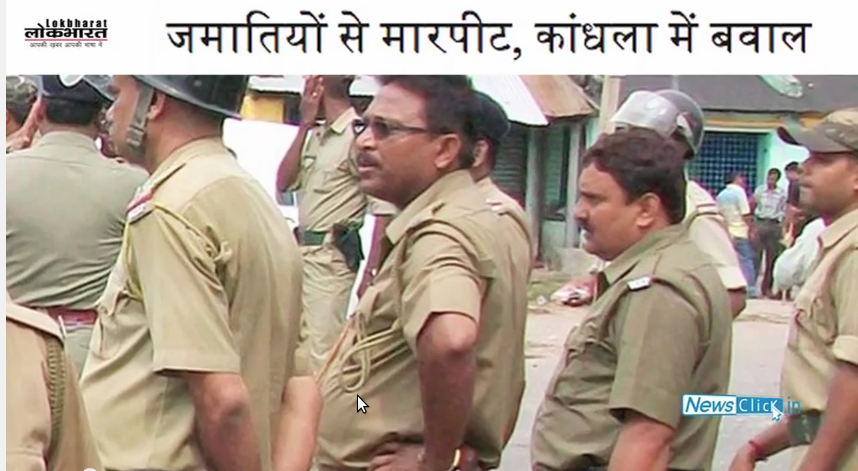
Pranjal: Hello and welcome to Newsclick. There has been a hashtag called Godhra again on twitter which talks about killing 3000 Muslims in Shamli district of Uttar Pradesh. We are going to discuss about the issue with documentary film maker Nakul Singh Sawney. He has been working on Muzaffarnagar and Shamli riots since 2013 and has recently his documentary film called Muzaffarnagar Baaqi Hai on Muzaffarnagar eventually. Hello Nakul. We have seen this hashtag called Godhra again which talks of killing 3000 Muslims in Shamli. So what is the context of this hashtag, this entire tweet which we... it has been widely circulated in the twitter and then later was withdrawn and then a case was filed against that person.
Nakul: To understand that we need to sort of step back and see it in a slightly larger context. First of all, what is the incidence in itself. The incident of some people from the Tablighi Jamaat who were going to Muzaffarnagar who got beaten up on the way passing through Shamli and Muzaffarnagar. Let's understand, this is something that has been happening in Muzaffarnagar repeatedly for at least two years now. Specially before massacre before September 2013 in Muzaffrnagar and Shamli districts. Say six to seven months before that massacre incidence of these kinds have been happening repeatedly where you know if there are some Muslims on the train and this often happens in this Delhi Saharanpur train passes through West UP specially through the sugarcane belt of the West UP. Now, what is often been happening is that there will be a group of six – seven people who identify evidently Muslims. When I say evidently, if they are sporting a beard, wearing a skull cap and so on, there has been several physical attacks on Muslims passing through these trains. There has been no police action against this, there has been no attempt that identifying the culprits. So first of all this is not an isolated incidence. There has been this kind of growing compounding anger. The protest which happened is a town called Kandla which is a Muslim dominated town in Shamli district, I mean what I hear from media reports about four to five thousand Muslims gathered at the railway station to block the railway tracks to do a rail roko kind of a protest. Now let's first of all understand the rail roko or this form of protest for stopping train by blocking the railway tracks is an age old form of protest that all political parties have been doing including the BJP when they were in opposition. They often turned violent. Now, I am not justifying the violence. But the point is the moment you see five thousand Muslims, doing this kind of a protest you immediately begin to vilify them. You immediately begin to project it as something bigger than actually is. Whereas you have seen all the time since India got independence or probably before that. This also needs to be seen in a slightly larger context. It's attempt at vilification. You see, if you follow, there is something in my film as well, if you follow the headlines in several regional newspapers, say for six to seven months before the massacre broke out, if there was a case of a Muslim man molesting a Hindu woman, it's funny how a lot of the regional media covered these incidents and specially the headlines. The headline would often say something like one man from a cetain community molests a girl from another community, rapes a girl from other community. Then when we investigate it we realize there were actually a lot more cases of Hindu men also molesting and raping Muslim women. The point is those were not reported like this. It would always be a case of molestation or it would always be a case of rape that was reported. The headline would never with one that pointed to a community as a whole. So that kind of vilification is something that we are seeing for a while and this is scary because if you look at the Sachar committee report, you will realize that actually the Muslim community in this country is economically, politically more backward than any other community in this country including the dalits. Now, you are then actually picking on the weakest community and trying to project them as a threat. That is actually it is a reminiscent of say how African Americans were vilified in US and this whole image of black rapist was projected. Something similar happening here and it is very scary trend. So this Godhra again hashtag on twitter or on facebook, this is really a continuation of that. It has to be seen in this context of picking out a community. I mean the fact that just because you have people in skull caps and with beards wearing white kurta pyjamas you suddenly begin to believe that any protest by people dressed in a certain way has to have a certain communal connotation to it.
Pranjal: When you talk about these incidents which have been happening in Uttar Pradesh specifically, we also need to see the political conditions in Uttar Pradesh. Samajwadi Party is in government which has been often called secular parties by various forces in the country and they are taken as one among the front runners among in taking the issue of communalism inside the parliament, outside the parliament. What is this all about? What has SP done to prevent it or has it done anything on it or not? The other question is that in your film also you have talked about and how it has been told in the news reports also that the Muzaffarnagar Shamli riots, it is also a by-product of the fake video distributed in whattsup. So this increasing trend in social media is also some which is continuously attacking minority community.
Nakul: I completely agree with you. What we need to understand first of all while it is true that and I think tweets of this kind which says they killed three thousand Muslims or the fake video which was circulated on whatsapp in Muzaffarnagar and Shamli before the massacre broke out. Now, yes, action needs to be taken against those people who are perpetrating I mean who are indulging in rumor mongering to vitiate the atmosphere. I think the only answer to that is that sections of the secular progressive or Left leaning kind of activists or even others they need to start take their social media very seriously themselves. About your first question, that's been very true, I mean Samajwadi Party being in power. Now, if you look back, one of the things that need to be highlighted is that ever since the AkhileshYadav came to power, there were 200 big and small riots before the 2013 massacre and even after the May 2014 BJP government came to power in the centre, in UP according to very extensive report in the Indian Express in August 2014, there has been around 600 riots. This is actually August 2014. so God alone knows how many more have happened after that. Now, the point is and lot of these cases when you begin to investigate them, you realize the local BJP, the local RSS, the sangh parivar at one level is involved in them. But the point also is that even in this rail roko, the local SP candidate, the local SP MLA Nahid Hasan was very much there to instigate the crowd. Now the point is the SP itself is not playing a responsible role when it comes to stopping this kind of violence. There is also you see vested interest in this kind of polarization themselves. They want this polarization to build because they think they will be able to consolidate Muslim votes in that process when there is this kind of religious polarization. It is this kind of very cynical very opportunistic politics which sort of clears the path for BJP RSS growth as well. I mean there is this fear of this RSS among the minorities and it is a very legitimate fear and there is an anger among them as well. But, that is all that SP is able to do which is that whip up the fear against the RSS and get minority votes on the basis of that. However, if you look at the social indicators of UP, social and economic indicators specially among the Muslim community in UP, what is the SP government able to achieve? Nothing for the Muslims. So really, this kind of strategic secularism, that's the term that I heard recently, which I describes the parties like SP very well which is you use it as a tool when it works for you and you dump it when it doesn't work for you. You see, even the kind of politics which Azam Khan is practicing in Rampur, this kind of politics if that's how you plan to fight the BJP and the RSS I am sorry but you are not fighting them you are just making them stronger.
Pranjal: Nakul, it would be my last question since the new government has come to the power. The Prime Minister has been talking about being very media savvy, being very social media savvy, he has been on twitter on facebook everywhere. But the continuous attacks on minorities have increased when he goes outside he preaches something else. So what's the way ahead for progressive parties, what's the way ahead for the Left parties who have not given any comment on such issues and last thing would be BSP is the major player in Uttar Pradesh and when there is attack on minorities, we also need to see that there is a backlash on dalit also. So what role BSP has on this entire movement?
Nakul: I think it is a very good question. Your first question, which is about progressive forces in this country and you are talk about Left parties as well. There are progressive forces outside mainstream Left parties as well. But nonetheless, I think what is important is we need to understand.. well you are right, the Prime Minister goes out he speaks another language, when he is another country he will talk about secularism and how India's secularism needs to be upheald so on and so forth. But I mean what is happening in the ground is for everyone to see. One of their MP makes a statement, some of the leaders make statements saying voting rights of the Muslims should be taken away, others make speeches like Ramzada, Haramzada and this is just happening endlessly. At the same time unfortunately, when you are saying there is no reaction from Left parties, there have been just paper reactions if you know what I mean. It's not just translated into anything substantial on the ground. I think it's important to understand the parties like the SP, the JD(U), RJD and even the Congress these are the parties that have sort of practiced like I said earlier practiced the kind of strategic secularism and I really think it is time then, second part of the answer actually comes from the second question which is that finally yes, communalism in this country is largely an extension of Brahminical ideology of the Manuwadi ideology so in that sense it is very very deeply anti dalit and deeply anti women as well. There is obviously the desperation to uphold the Brahminical order as well and that is really at the core of the RSS. So if you have to fight and I think this is the where the BSP is also going wrong because I think, the BSP played a very important role under Kanshi Ram and later under Mayawati to some extent in organising dalits and giving them a very strong voice in Uttar Pradesh. On the the one hand you are looking at secularism in isolation and not understanding how it is deeply linked to the battle for rights, to the struggle for dalit rights, how it is deeply linked to the struggle for women's rights. How it is deeply linked to the battle against corporate greeds. If these movements, if these struggles do not come together, I think we are fighting a loosing battle. Looking secularism in isolation and just saying Hindu, Muslim, Sikh, Isai Aapas Main Sab Bhai Bhai. It's not enough. I think that's the one mistake we have been making. We are looking secularism as an isolated concept.
Pranjal: Thank you for giving us your time. Thank you for watching Newsclick.
Get the latest reports & analysis with people's perspective on Protests, movements & deep analytical videos, discussions of the current affairs in your Telegram app. Subscribe to NewsClick's Telegram channel & get Real-Time updates on stories, as they get published on our website.









